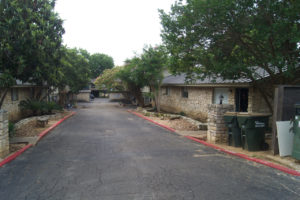
This apartment complex fits into the neighborhood well with hidden parking and density.
Saturday, May 14th was a day marked by very high humidity in Austin. But, it paled in comparison to the soaring home and rental prices in the Zilker neighborhood just west of South Lamar. That’s where an inspired group of Austinites began a stroll down quiet city streets and through the pages of the recently-published CodeNEXT Household Affordability Code Prescription. Leading the way was Paul DiGiuseppe, Principal Planner in the City’s Planning and Development Review Department.
DiGiuseppe said, “The reason we chose the Zilker neighborhood, is it’s a good representation of a community that has different types of housing from single family… duplexes, small apartments.” As a close-in, established neighborhood, Zilker is also experiencing a significant amount of redevelopment and soaring housing prices.
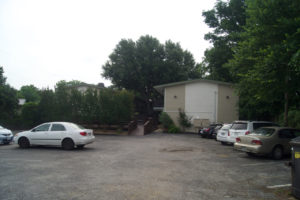
This apartment complex has a large parking lot that is very visible from the street.
The tour began with an analysis of small apartment complexes across from Zilker Elementary School. The group seemed to agree that a complex that had its parking area underneath the building and its two-story section set far away from the road seemed to hide its density well and integrate more seamlessly within the neighborhood.
City Planner Jonathan Tomko said that brought up an important point. “That’s certainly a challenge with our current code. Zoning categories are normally applied across the board in a uniform fashion,” said Tomko. “The challenge we are trying to address is how can you get uses like this but built in a way that really fits in more appropriately with the existing neighborhood.”
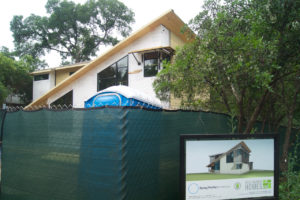
A luxury home being built in the Zilker Neighborhood.
Tomko offered neighborhood-specific statistics from the 2014 Comprehensive Housing Market Study, showing that there was only a 26 percent chance that artists or musicians earning about $31,000/year could afford to rent in the neighborhood and only a two percent chance they could afford to buy a home. Tomko highlighted an important question posed in the Household Affordability Code Prescription – How might we increase housing supply and diversity to increase affordability while preserving what is unique and special about Austin?
HousingWorks Executive Director Mandy De Mayo, a member of the Land Development Code Advisory Group (CAG), shared some concerns about using trade-offs to allow denser housing types. De Mayo said, “Just like we do with vertical mixed use, I would want to make sure we’re not just getting more units, which there’s value in more units, but the true value is getting that legally binding affordability.”
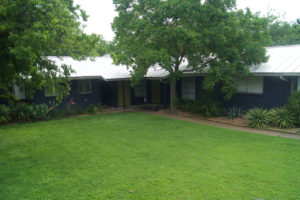
This duplex has plenty of green space
As the tour moved on, the group reached a duplex that had plenty of green features and tree coverage. It fit in with the character of the neighborhood, but at $1,700 for rent it certainly wouldn’t be affordable for the average Austin family. Nuria Zaragoza, also a member of the CAG, expressed concern about adding entitlements that might bring more housing units but not necessarily more affordable units. As Zaragoza observed, it’s often the older housing that’s likely to be more affordable.
Much of the discussion centered around parking. City staff pointed out that wide driveways had taken away much of the green space in the neighborhood and all that impervious cover only adds to the risk of flooding. CAG member and Zilker resident Eleanor McKinney said she would like to see more driveways built with pervious pavers that would still accept storm water.
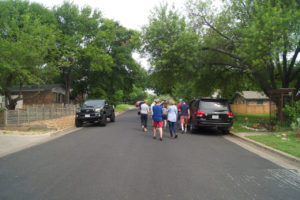
Tour participants are forced to walk in the middle of a street with no sidewalks.
Neighborhood resident David Piper warned that code changes to reduce the size of driveways would only result in more cars parked along the street and people walking in the street. Piper said, “If you fill it up with cars on both sides, the walkability goes away with no sidewalks.”
One of the last stops on the tour was at the Sasona Coop, a 16-unit property tucked away on an acre of property at the end of a dead end street. Residents spoke to the group about the way they share meals, chores and common areas and about the democratic way in which they govern day-to-day issues. It’s a creative way to bring more affordable housing stock with little or no negative effect on neighborhoods that many people haven’t considered. There will be follow up conversations with the cooperative members about how their housing model could be replicated in other areas of Austin and how the land development code can help (or hinder) their success.
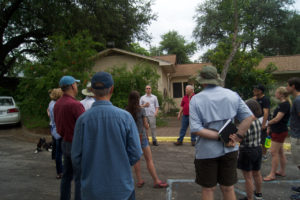
The tour visits the Sasona Coop.
At the end of the walk, it was clear that there are no easy answers. The group discussed a range of topics, including density, affordability, preservation, parking, traffic, mobility, public transportation, green infrastructure, and flooding. Austinites hold a variety of community values, which often times are at odds with each other. The land development code is our opportunity to carefully consider and balance those tradeoffs in order to make the vision of Imagine Austin a reality.